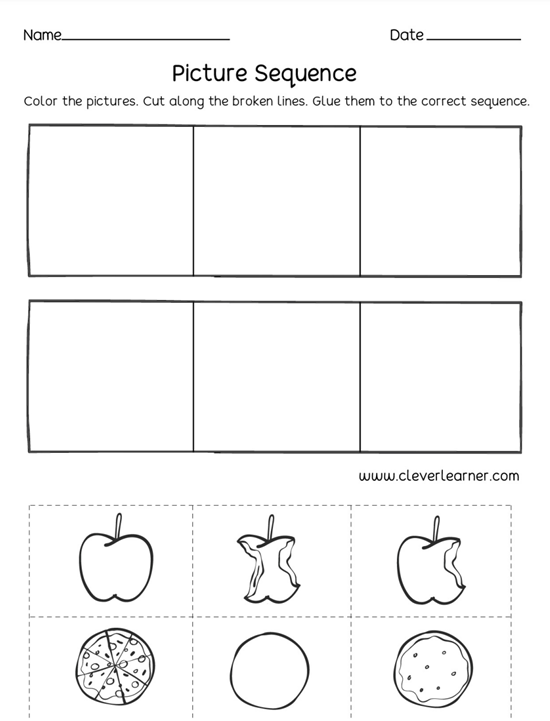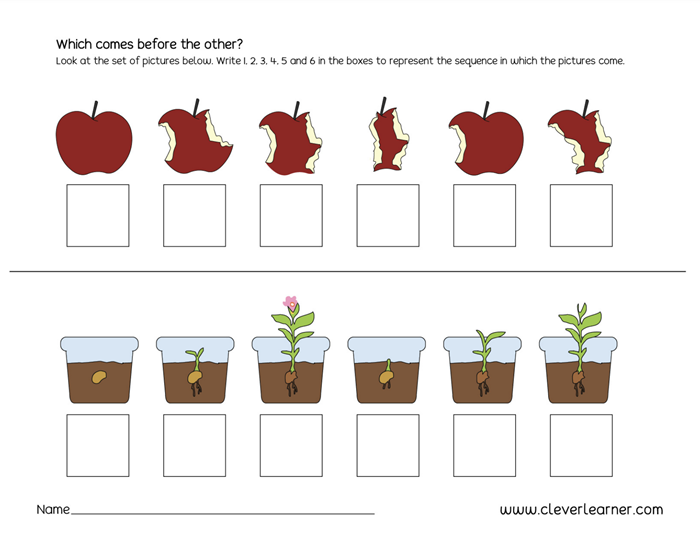Picture sequence activity worksheets are a fun and engaging way to boost children’s cognitive development while sparking their creativity. By arranging images in a logical order, children learn essential skills like pattern recognition, storytelling, and critical thinking. These activities not only foster a sense of accomplishment but also help develop fine motor skills and visual perception. Whether tailored for younger children with simple sequences or older kids with more complex scenarios, picture sequencing can be easily adapted to suit different age groups. Moreover, working on these activities in a group setting encourages collaboration, communication, and social skills, making it an excellent choice for both individual learning and classroom environments.
Benefits of Picture Sequence Activity
Enhances Cognitive Development
Picture sequence activities help children develop critical thinking and problem-solving skills by encouraging them to analyze and organize visual information. As children figure out the correct order of events, they strengthen their understanding of cause-and-effect relationships and improve their logical reasoning abilities. This type of activity also supports the development of memory as they recall details to create a coherent story or process.
Boosts Language and Storytelling Skills
Sequencing pictures is a great way to build language skills. Children can narrate the story or explain the sequence of events as they arrange the images, helping to expand their vocabulary and improve sentence structure. This activity also encourages creative storytelling, as kids can add details and imaginative elements to the sequences they create.
Supports Fine Motor Skills
Engaging in picture sequence worksheets often involves cutting, pasting, or drawing, which are excellent ways to enhance fine motor skills. These tasks help children develop hand-eye coordination and dexterity, which are essential for writing and other precision-based activities.
Builds Visual Perception and Pattern Recognition
Picture sequencing improves a child’s ability to observe and interpret visual cues. By focusing on details in each image, children learn to identify patterns and differences, strengthening their visual perception skills. This ability is essential for recognizing letters, numbers, and shapes as they grow.
Encourages Social Interaction and Teamwork
When done in a group setting, picture sequence activities can promote collaboration and teamwork. Children can discuss their ideas, share perspectives, and work together to complete the sequence. This helps build communication skills and teaches them the value of cooperation and listening to others.
Develops Emotional Understanding
Many picture sequencing activities involve stories with characters experiencing various emotions. As children arrange the sequence, they often identify with the characters’ feelings, which can enhance their emotional intelligence and empathy. This helps them understand and relate to real-life situations more effectively.
Picture Sequence Activity Worksheets
How to Get Started
To begin with picture sequence activities, choose or create worksheets that feature a series of images representing a clear process, story, or event. Start with simple sequences, such as daily routines (e.g., brushing teeth, eating breakfast), to help children grasp the concept. Provide scissors, glue, and blank sheets for kids to arrange and stick the images in the correct order. You can also use pre-cut images or laminated cards for a reusable option. Explain the activity with an example sequence, guiding children to observe the details in each image and think critically about what happens next.
How to Tailor to Different Age Groups
For younger children, opt for simple sequences with fewer steps and clear, easily recognizable images. Include prompts or labels to guide them through the process. For preschoolers, sequencing activities with familiar themes, such as animals or seasonal events, work well. Older children can handle more complex sequences, such as storytelling with multiple characters or abstract concepts like life cycles. You can also add a creative element for older kids by asking them to draw or write captions for each step, encouraging them to think deeper and personalize the activity.
Where to Get the Worksheets
There are just so many different types of worksheets out there for this specific activity, and we are going to point you to some amazing websites where you can get them. Remember that the worksheets that you use should be catered to your child’s age and developmental stage. Getting the right worksheet is really the key to keep your young learners engaged and interested.
If you are doing picture sequencing activity with young toddlers, you can start with these worksheets by Clever Learner. These worksheets are really great to introduce the concept of sequences to a child. The worksheets are not too complicated, with only 3 – 4 parts of a sequence. It also incorporates cutting and pasting into this activity, which adds an extra layer of fun and a hands-on element to keep your little children engaged.


With older children, you can go with this worksheet that requires them to sequence more pictures. Picture sequence activity is also a great way to help older children learn many different science concepts such as germination and plant growth.

Picture sequencing activity is also a great way to help your children understand, visualize and remember every day habits, for example, morning, bed time or after school routines. This worksheet from Turtle Diary is a good one for this specific purpose. You can even use this worksheet as a check list for your child to help them complete these routines!

Primary school children will really benefit from doing this worksheet by 15 Worksheets. This specific worksheet gets your children to read and sequence a simple story, which gets them to exercise various skills such as reading and logical reasoning!

A Fun Group Activity
Yes, picture sequencing is a highly engaging group activity! When done in a group setting, children can collaborate to solve the sequence, discuss their ideas, and share creative interpretations of the story or process. It adds a layer of excitement as kids compare their thoughts and work together to decide the correct order. Group activities also introduce an element of friendly competition, where teams can race to complete the sequence first, or take turns narrating their arranged sequences, making it both educational and entertaining.
How to Invite Other Parents to Join
To invite other parents to join, consider organizing a small playdate or community event focused on picture sequencing. Share how the activity supports cognitive and social development, emphasizing the fun and creative aspects. You can provide sample worksheets or demonstrate the activity during the event. Spread the word through parent groups, social media, or school bulletins, and encourage parents to bring their children along. Highlight how this activity fosters teamwork and is a great opportunity for kids to bond and learn together. Offering take-home worksheets as a follow-up can also encourage parents to explore the activity further.
And to help you out with inviting other parents, you should definitely check out our invitation templates. Whether to send as a personal invitation or as a social media post, these templates have fun and adorable designs that will help create excitement. Head to 8+ Cute Cartoon Airplane For Boys Birthday Invitation Templates and 11+ Magical Unicorn Birthday Invitation Templates With Colorful Pastel Rainbow for many different designs, all you have to do is download the templates and edit in the details to your party sequence playdate!
Picture sequence activities are a wonderful way to engage children in learning while nurturing their creativity and critical thinking skills. From building logical reasoning to enhancing storytelling abilities, this activity provides a wide range of developmental benefits. Whether done individually or in a group setting, it is versatile, enjoyable, and easy to adapt to various age groups and learning needs.
By incorporating picture sequence activity into playtime or educational settings, parents and educators can create meaningful learning experiences that are both fun and enriching. With its combination of hands-on engagement and imaginative exploration, this activity encourages collaboration, communication, and problem-solving in a way that feels like play. Give it a try, and watch children’s confidence and skills grow as they master each sequence!
































